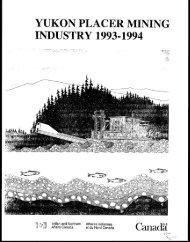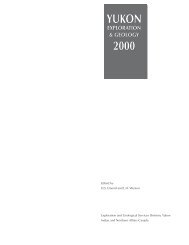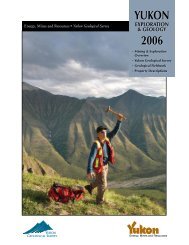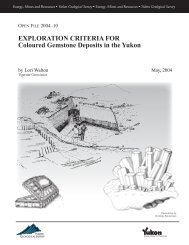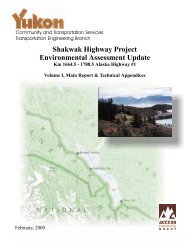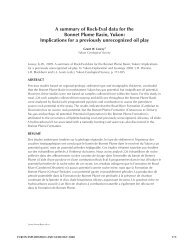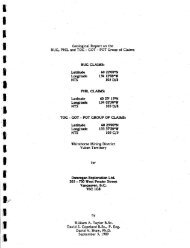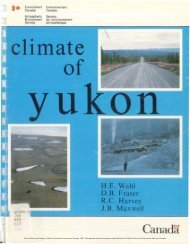Eagle_Plain_matting_..
Eagle_Plain_matting_..
Eagle_Plain_matting_..
Create successful ePaper yourself
Turn your PDF publications into a flip-book with our unique Google optimized e-Paper software.
Table 1: Vegetation Species List – Camp 204 Access Mat Test Site, <strong>Eagle</strong> <strong>Plain</strong>s, YT<br />
PLANT COMMON NAME SPECIES April 8,<br />
2008 site<br />
visit<br />
11<br />
Sept 5,<br />
2008 site<br />
visit<br />
1 black spruce picea mari x x<br />
2 bog cranberry vaccinium oxycoccos x x<br />
3 (bog?) blueberry vaccinium sp x x<br />
4 horsetail equisetum x x<br />
5 various grasses graminoids x x<br />
6 sphagnum moss sphagnum sp x x<br />
7 reindeer lichen cladina sp x x<br />
8 “leaf” lichen peltigera sp x<br />
northern labrador ledum palustre<br />
9 tea<br />
var.decumbens x x<br />
10 dwarf or bog birch betula sp x<br />
The general structural condition of vegetation where mats had been placed for about 5 months<br />
(April 9 to September 5, 2009) was good. Some minor flattening due to compression in high<br />
micro‐relief areas was evident. There was no ground disturbance observed, e.g., soil exposure<br />
due to gouging, scraping, sliding or other lateral movement (Appendix B – field notes). Insect<br />
webs and vole paths (Photo 10) were developed in large parts of the mat placement area,<br />
indicating that the access mats provided protected habitat for insects and small mammals. Drill<br />
cuttings from thermistor boreholes were observed to have some affect on vegetation underlying<br />
the access mats. Apparent bare patches shown in Photo 9 are areas where accumulated drill<br />
cuttings have covered vegetation and may impede growth and recovery. In future tests, drill<br />
cuttings should be carefully removed as they have compounded effects being observed and<br />
slightly reduced the vegetation area available for this study. The vegetation assessment was<br />
scheduled at the test site three weeks following access mat removal was postponed to a mid‐<br />
summer assessment in July 2009 due to the late scheduling of mat removal and the onset of<br />
winter conditions.<br />
Field assessment work requirements for the test site were evaluated by NCY in the spring of<br />
2009, and a “punch list” of items that were to be completed on site was prepared and discussed<br />
with EBA. Vegetation assessment, thermistor downloads and equipment maintenance was<br />
performed by David Scott‐McQuinn of EBA in July 2009; Greg Charlie represented NCY on site.<br />
NCY considers that the same scientist doing each assessment allowed generation of the most<br />
consistent scientific vegetation data possible. The work performed was at the direction of NCY<br />
(Peter Moignard). Thermistor dataloggers were exposed to casual visitors, so on August 7th,<br />
2009, Chris Jastrebski of EBA applied camouflage coverings to the cables and boxes when he was<br />
correcting problems with the HOBO weather station.



